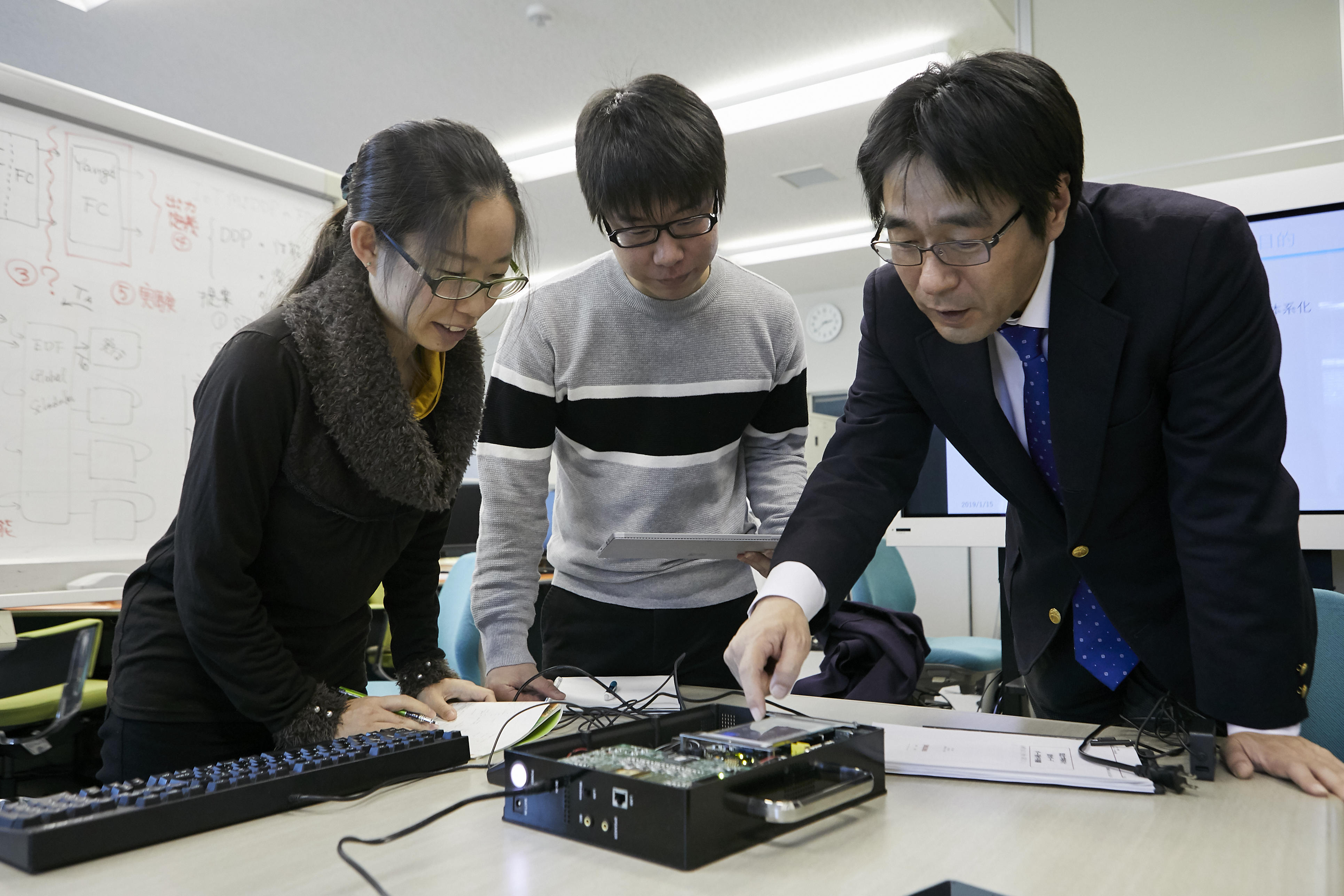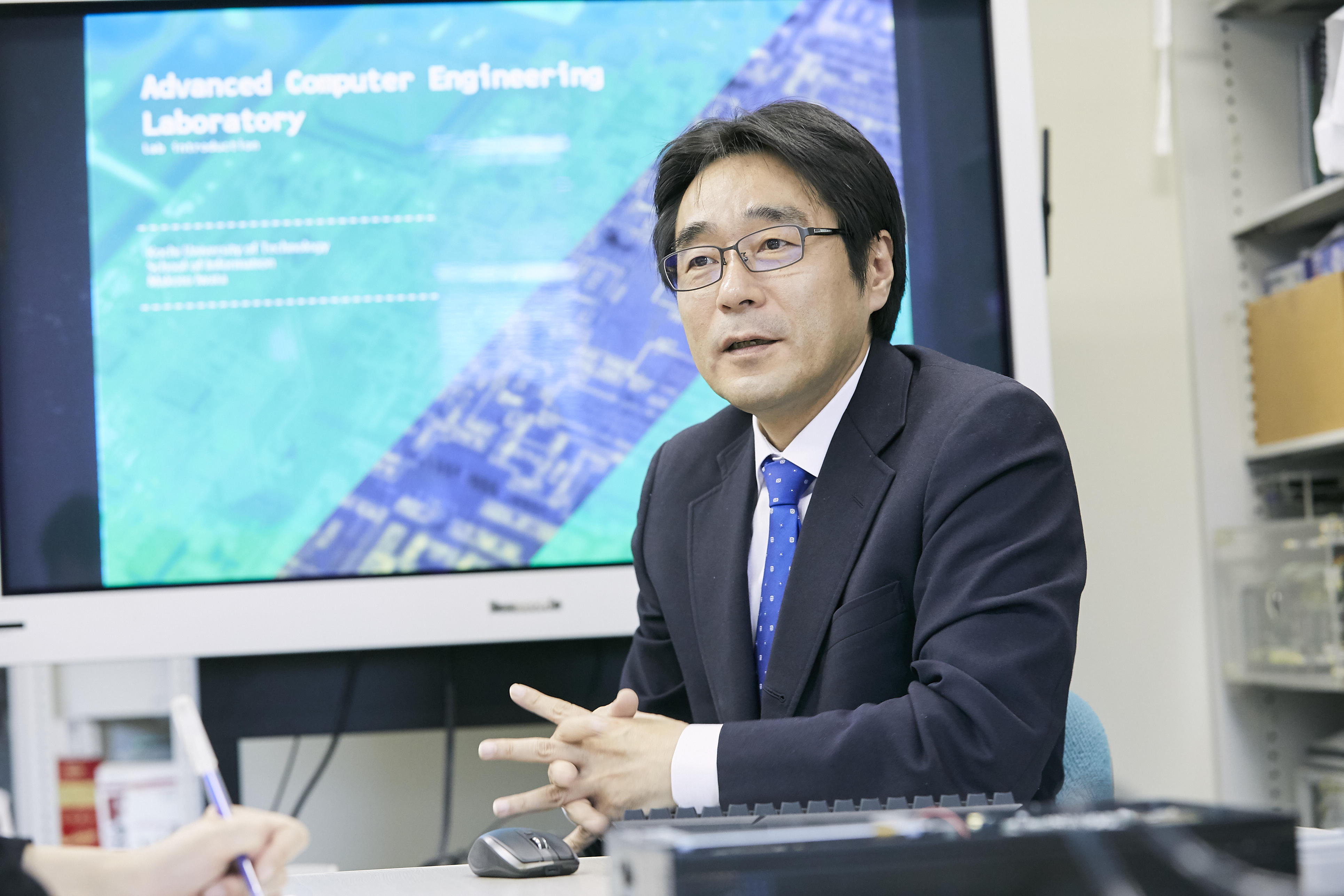- TOP
- Cutting-edge Research and Social Contribution
- Cutting-edge Research
- Making the information society sustainable with outstanding power-saving technology

Making the information society sustainable with outstanding power-saving technology

IWATA Makoto
- Specialized field
Computer architecture, methodology for development of information and communication systems
How does a data-driven system save power?
Now, in the age of the Internet of Things (IoT), in which sensors and devices are embedded in every object around us, connecting them to networks, we are moving into a world where new value is created using various kinds of data. In US industry, there is a movement towards a new society, the Trillion Sensors Universe, that utilizes one trillion sensors every year. In order to move the information society towards sustainability, power-saving in information communication equipment is considered an essential technology.
At the core of information and communication equipment are large-scale integrated circuits (LSIs) that process vast amounts of information. Most of the current LSI chips operate in synchronization with a high-speed clock at several hundred MHz to several GHz. It is said that the power required for propagation of this clock signal accounts for 30% of total LSI power consumption.
In that setting, Professor Iwata has been conducting research toward the development of power-saving technology for many years, focusing on "self-timed circuits" that only transmit and receive data between adjacent circuit blocks. Since self-timed circuits do not use a clock signal, no power is needed for propagation of a clock signal; this results in significant power saving. In other words, self-timed circuits do not perform unnecessary processing.
Prof. Iwata explains, "In many methods of the current control drive type, the clock signal is always distributed to the whole LSI and power is consumed even in standby mode. On the other hand, in the data-driven system, clock signals are not used. Rather, the data-driven system is like a bucket-brigade: when a data calculation is complete, the data are passed on in sequence to be used in other locations. In that way, when the data arrives, it can operate in only the necessary locations. That is, power is not used in unnecessary locations, which results in remarkable power savings."
In 1997, Prof. Iwata and his colleague succeeded in making a commercial multiprocessor chip for LSI, using a self-timed circuit. At that time, the chip achieved the world's highest level of performance per Watt. This achievement in development of an LSI that actually operates using the data-driven principle was quite uncommon in the world at that time.
Contributing to the realization of innovative sensor network systems
With the huge increase in the number of information and communication devices, the issue of maintenance is of renewed importance. In the conventional control drive method, the power required for processing of sensor information and the like cannot be predicted accurately. The related problem of unexpected battery exhaustion has been regarded as unavoidable. On the other hand, since the data-driven system can continue to operate autonomously even if an abnormality occurs, data-driven technology is expected to solve such problems.
Prof. Iwata continues, "As the number of devices increases, eventually we will not be able to function with the old system of waiting until the system breaks down. It will be essential to predict in advance when the system is likely to break down, and to perform preventive maintenance accordingly. Since data-driven processors do not involve any inefficient processing, it will be possible to predict accurately the amount of power consumption and to prevent the system from running out of battery power. As a result, we will be capable of planned maintenance and operation of information communication equipment."
In recent years, the topic of water privatization has often been in the news. If a data-driven processor is used for monitoring phenomena (such as deterioration of water pipes) that have until now required human monitoring, we will be able to efficiently perform water pipe replacement, and as a result reduce labor costs. It appears that data-driven processors will enable us to reduce both facility costs and labor costs for this kind of public infrastructure.
This is not the only benefit of data-driven processors. For example, even when data is being processed, other data can be received and processed in parallel, so it is possible to simultaneously process data with widely different frequencies of occurrence, such as continuous video data and discontinuous sound data. Furthermore, unlike control-driven processor systems based on the premise that data is stored in a memory, in data-driven systems data is directly inputted to the processor without being written to memory, so there is no delay due to reading and writing input data to memory.
Utilizing these features, it will be possible to perform advanced sensing using cameras (which has been difficult in the past) and wireless sensor networking systems to monitor the deterioration of facilities such as bridges, expressways and tunnels. This, then, is essential technology for achieving innovative sensor network systems with higher reliability than ever before.
In order to spread the adoption of data-driven processor technology, Prof. Iwata established a venture company with co-researchers at Tsukuba University in March 2018. They have been preparing steadily for the commercialization of the technology. Finally, after many years under development, data-driven processor technology is about to be released to the world.
Fusion research: synergy with brain science towards next-generation brain-like computers
Prof. Iwata says, "When I was a high school student the price of computers went down and suddenly individuals could afford to buy them." He saved up, and finally bought a personal computer. This set the course of his life. As computer technology developed, his interest in information engineering deepened. Strongly believing that, "This is the beginning of the computer age," he entered the Department of Electronic Engineering of Osaka University. He found his current research theme when he was a fourth year undergraduate, and he has been working steadily on that same theme for over 30 years.
"When I was in university, I joined the laboratory of Professor Hiroaki Terada, who later became vice-president of KUT. Prof. Terada said, "This is the age of LSI chips, and it is important to create data-driven processors suitable for LSI." That was when I started working on this topic. It was the starting point of everything for me."
Prof. Iwata's most recent research interest is the working of the human brain. Since 2017, he has been the director of the Research Center for Brain Communication at KUT Research Institute, and he is now focusing on research that combines brain science and information and communication technology. Prof. Iwata says that he found an important fact while working to deepen his knowledge of the brain: the data-driven processors he has been developing over the years work very well with human brain structure. What exactly does that mean?
Prof. Iwata explains, "The human brain is made up of about 100 billion neurons, all interconnected by networks. Information is transported like a bucket-brigade from one neuron to the next. Even when we are doing complex tasks, calorie consumption is stunningly low, exactly the same as in the mechanism of the data-driven method that we have been researching for many years. Even lower power consumption in LSI processors could become a reality if we can elucidate the mechanism of power saving in the brain."
Prof. Iwata has extended his data system work to the mechanism of the human brain, leading to new applications.
"There are a huge number of neurons in the human brain, far more than the number of transistors that can be integrated into current LSI circuits. In the future, if the degree of LSI integration increases and we can create LSIs with density similar to that of the brain, it may be possible to create brain-like computers that could replace a human brain damaged in a stroke or an accident."
Creation of a brain computer that can mimic the human brain is Prof. Iwata's long-standing dream. As a step in that direction, he and his students have started research on and development of neural networks which behave exactly the same way as neurons in the brain.
Prof. Iwata says, "We know that there is still a big gap between the mechanism of actual neural networks and the deep learning artificial intelligence neural networks that are currently attracting so much attention. Our goal then is to create the simplest model mechanism that resembles nerve cells as closely as possible, and implement it as a circuit on an LSI chip. When computer performance improves sufficiently in the future, the time will come when we'll be able to create a computer model that functions like a human brain. I would like to create the circuit that can be the basis for such next generation computers."
The human brain is an ideal system for realization of a sustainable information society. The time is approaching when fusion research with brain science will make it possible to realize an intelligent next-generation computer that is very like a human brain.
